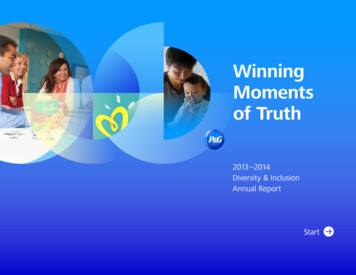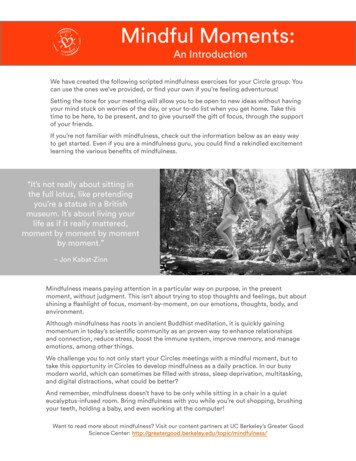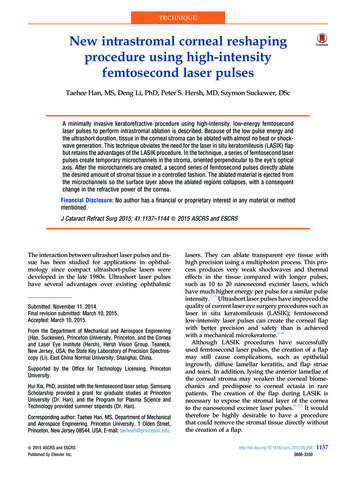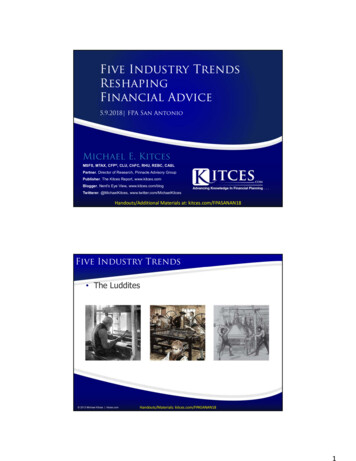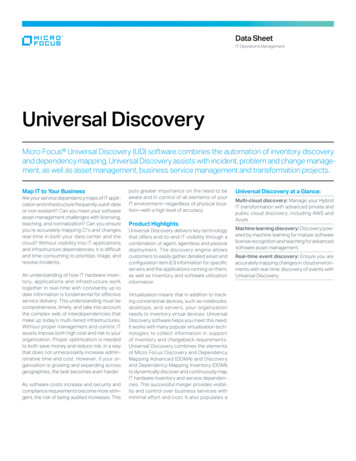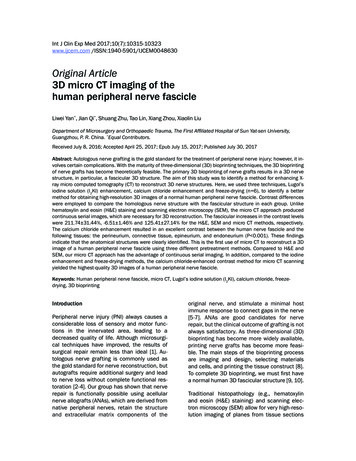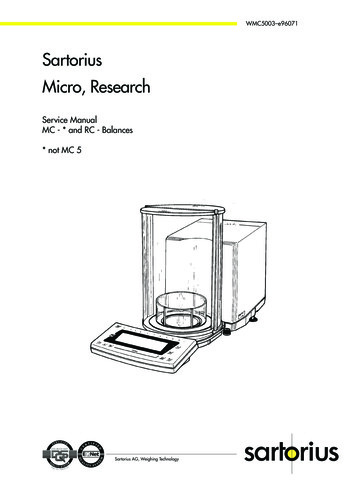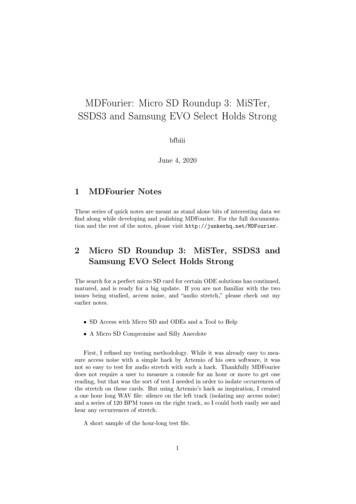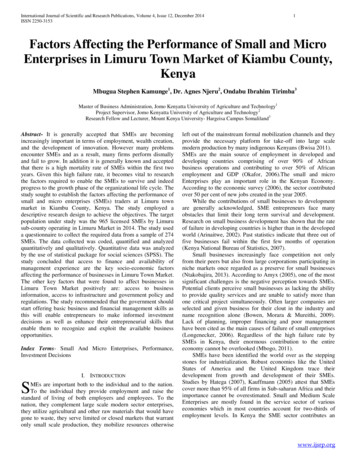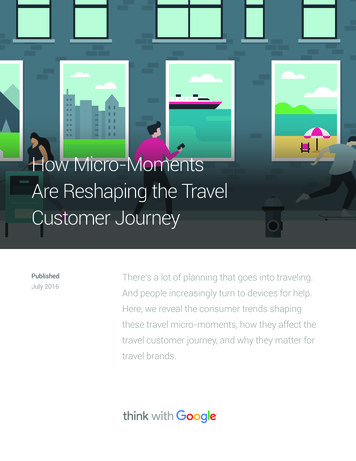
Transcription
How Micro-MomentsAre Reshaping the TravelCustomer JourneyPublishedJuly 2016There’s a lot of planning that goes into traveling.And people increasingly turn to devices for help.Here, we reveal the consumer trends shapingthese travel micro-moments, how they affect thetravel customer journey, and why they matter fortravel brands.
WWhat do people spend more discretionary income on thanhome improvements, financial investments, or even healthrelated products?Travel.A trip was the largest discretionary purchase last year according to nearly60% of leisure travelers.1Before making this investment, travelers are taking time to research allthe possibilities. Over 40% of travelers say they bounce back and forthbetween dreaming about and planning their next trip—zooming in on thedetails for one destination and then zooming out to reconsider all theoptions again.2And more and more of this time is spent researching the details of tripson mobile. As of the first quarter of 2016, 40% of U.S. travel site visitscome from mobile.3As more research happens in the traveler’s customer journey, thereare more micro-moments—when people turn to a device with intent toanswer an immediate need. In these moments, the stakes are high fortravel brands as preferences are shaped and decisions are made. Whathappens in these micro-moments ultimately affects the travel decisionmaking process.40% of U.S. travel site visits come from mobile.How consumer behavior is shaping travel industrytrendsDesktop still plays a big role in travel research, no doubt. But 40% of U.S.travel site visits are now coming from mobile. And consider this: Thelength of those sessions has shrunk by 5%.3 With more frequent andshorter sessions you might conclude that consumers aren’t finding whatthinkwithgoogle.com2
they want on mobile. Yet conversion rates have grown nearly 10% onmobile travel sites.4Let's break that down: Travelers increasingly turn to mobile in shorterspurts to make informed decisions faster than ever before. For marketers,this phenomenon has huge implications for the entire travel decisionjourney across devices and channels.Travel moments that matterthinkwithgoogle.com3
Travel micro-moments start when people begin dreaming of a trip, andthey continue all the way through the long-awaited trip itself. Thesemoments tend to fall into one of four categories, which map closely tothe stages of the travel decision-making process: dreaming, planning,booking, and experiencing.I-want-to-get-away moments: a.k.a. “dreaming moments” that happenwhen people are exploring destination options and ideas with no firmplans. At this stage, people are looking for inspiration.Time-to-make-a-plan moments: a.k.a. “planning moments” thathappen when people have chosen a destination. They’re looking for theright dates, the right flight, the right place to stay, and all the things they’lldo while they’re there.Let’s-book-it-moments: a.k.a. “booking moments” that happen whenthe research is done, and people are ready to book their tickets andreserve their rooms.Can’t-wait-to-explore moments: a.k.a. “experiencing moments” thathappen when the trip is underway. Travelers are ready to live the tripthey’ve been dreaming about—and share it with others.Creating a travel micro-moments strategyWhy does all of this matter for travel brands?Seventy-two percent of travelers with smartphones agree that whenresearching on their smartphones, they look for the most relevantinformation regardless of the travel company providing the information.5In other words, they're more loyal to their need than to any particularbrand.For travel brands, this means you have to earn (and re-earn) eachperson’s consideration in every micro-moment they experience. How?thinkwithgoogle.com4
Be there. You can't win if you're not in the game. Identify the micromoments for travelers that fit your business, then commit to beingthere to help when they happen. Be useful. If you want to win the hearts and minds (and business) oftravelers, you’ll need to do more than just show up. Be relevant to theperson’s need in that moment. Connect them to the inspiration they’relooking for and to the answers they want.To be there and be useful across all travel moments, think about theintersection of these two. Try mapping out the customer’s path topurchase. What is the traveler’s need that you’re solving for, what is theircurrent situation or context, and how can your brand help?Red Roof Inn provides a great example of how to combine intent withcontext to address a specific need for the stranded traveler. Realizing thatflight cancellations leave an average of 90,000 U.S. passengers strandedevery day, the Red Roof Inn marketing team developed a way to trackflight delays in real time and trigger targeted search ads for their hotelsnear airports. These ads said, in essence, “Stranded at the airport? Comestay with us!”They committed to those let’s-book-it moments and delivered withrelevance on people’s needs. The result: a remarkable 60% increase inbookings across non-branded search campaigns.The business case for micro-moments thinking is clear. According torecent research that Google commissioned from Forrester Consulting,companies that take steps toward being moments-ready earn a markedlystronger ROI in both mobile and overall marketing investments.In this article, we’ll explore: The latest consumer trends that define each of these travel micromoments and how they’re affecting travel industry trends.thinkwithgoogle.com5
Snapshots of real travelers’ research journeys, including the searches,clicks, website visits, and video views on their way to booking. Actionable ideas for travel marketers to be there and to be useful ineach type of micro-moment. Examples of travel brands that are already seeing success withmicro-moments thinking.thinkwithgoogle.com6
I-Want-to-Get-AwayMoments: What They Meanfor Travel MarketingHalf the fun in traveling is dreaming up thedestination. Here, we dive into I-want-to-get-awaymoments—the dreaming moments before a trip isplanned—and how travel marketers can capitalizeon these early moments of inspiration.thinkwithgoogle.com7
You know the feeling. Maybe you’ve just gotten back from yourmost recent trip. Or maybe you can’t remember the last timeyou even took a trip. Regardless of when it strikes you, you canprobably relate to the vacation itch.In these I-want-to-get-away moments, people are at the early stages ofthinking about their next trip. They’re exploring destination options anddreaming about what their next getaway could look like.Most consumers aren't brand-committed in these moments. Forexample, 78% of leisure travelers haven’t decided what airline they willtravel with, and 82% haven’t chosen the accommodation provider they willbook with when they first start thinking about a trip.6Source: Google/IpsosMediaCT, “The 2015Traveler's Road toDecision,” base: U.S.leisure travelers whobooked a flight inthe last six months,n 1,798; base: U.S.leisure travelers whobooked overnightaccommodation in thelast six months, n 2,711,Aug. 2015Not only have travelers not decided on what brand they’ll book with, butthey don’t necessarily have a destination picked out either. When firstthinking about a personal trip, one in three travelers says they haven’ttypically decided on a specific destination.2 Since many travelers still havean open mind about where they’ll go and who they’ll book with, these areprime opportunities for travel brands to make an impression.thinkwithgoogle.com8
Snapshot of a real traveler’s decision-making journeyOnline interactions are increasingly shaping how people dream uptheir next trip. New clickstream data from Luth Research’s opt-in panel(illustrating the pages a user visited, and in which order) provides asnapshot of what a real traveler’s I-want-to-get-away moments actuallylooked like. By analyzing this traveler’s searches, clicks, website visits,and video views while he was in dreaming mode for his upcoming travelplans, we can start to see exactly how and how much digital played a rolein influencing his destinations.Meet Liam. Liam is 30 years old, and he’s not just planning one trip, butthree: a vacation to Miami, a trip for his friends’ wedding in the NortheastU.S., and his own destination wedding in the Dominican Republic. He'salso open to planning even more travel, should he be inspired during hisresearch.Take a look at Liam’s travel micro-moments over the course of fourmonths:Source: Googlepartnered with Luthto analyze the digitalactivity of its opt-inpanel participantsduring a one-month,live-tracking study. Thisarticle details the crossdevice clickstreamdata of one of thoseparticipants. Liam isa pseudonym. Theparticipant agreed tothe publication of thisresearch for marketingpurposes under thecondition of anonymity.Liam did not discloseAnd here’s a real sample of one of Liam’s research paths in an I-want-toget-away moment that started with a search:mobile data, so all datais desktop-only.thinkwithgoogle.com9
Source: Google/Mindswarms, U.S.Methodology: Googlepartnered withMindswarms to selectand interview theparticipants of this livetracking pilot study. Theparticipants answeredquestions about theirshopping behaviors anddigital activity via video.How to win I-want-to-get-away moments: Be there andbe usefulAt this early stage in the travel decision-making process, people wantbrands to provide content to inspire and to help narrow down choices.What’s in it for hotel marketers, airline marketers, and other travelmarketers? Sixty-seven percent of travelers are more likely to book with atravel brand that provides relevant information for the destinations they’reinterested in.2Here are some concrete tips for providing people with relevant and usefulcontent in their I-want-to-get-away moments:Ensure you’re showing up for the searches people are doing in thesemoments—even on mobile. If you want to be in the considerationset, you have to be present in the I-want-to-get-away moments. Andremember that the smallest screen increasingly helps plan the biggest ofpurchases, travel included.Food for thought as you consider your “be there” search strategy: Peoplethinkwithgoogle.com10
often search for inspiration for vacation destinations based on geographyor on a type of trip someone has in mind. “Honeymoon destinations”and “europe destinations” are common searches we see like this onGoogle. While these searches happen on all screens, 60% of searchesfor destination information come from mobile devices.7 “Best time tovisit [destination]” searches are common as well, and increasingly so onmobile. As of March 2016, searches like this have increased 50% yearover year on smartphones.8Source: Destinations onGoogle Data, U.S., Mar.2016.Provide visual content for people’s I-want-to-get-away moments,especially on mobile. When it makes sense, highlight what theexperience will be like when they arrive, including what is available to seeand to do while on the trip.Travelers use Destinations on Google to learn about differentdestinations, explore points of interest, and get a snapshot of whata week-long trip might cost. From this behavior, we are able to gleaninsights into what is most useful for people as they decide where to gousing mobile. On the Travel Guide tab, one of the most engaged-withelements on the page is the main photo for that destination. We see thatpeople who tap on this image look at 10 images on average.4 This makessense, as 54% of leisure travelers say that pictures of a destination areimportant when choosing where to go.9thinkwithgoogle.com11
Introducing Destinationson GoogleVideo plays a big role in the dreaming stage. In any given month, over 100million of YouTube's unique visitors are travelers.10 Sixty-four percent ofpeople who watch travel-related videos do so when thinking about takinga trip.11 And three in five travelers who watch online video use it to narrowdown their brand, destination, or activity choices.11And travelers are watching more video on their smartphones. Infact, mobile screens are increasingly where travelers watch video:Approximately two-thirds of watch time for top travel videos happens onmobile.12 And that watch time on mobile devices has grown by over 65%year over year.12 This makes sense as travelers pick up their phones inslices of time throughout their day to learn about new places they want tovisit.When it comes to what kinds of videos travelers are watching, 65%of travelers search for videos online by destination. For example, topdestinations searched on YouTube include “barcelona,” “canada,” “dubai,”“australia,” and “new york.”13 And the most popular type of travel videoswatched on YouTube are travel vlogs.14thinkwithgoogle.com12
Source: Google/IpsosMediaCT, “The 2015Traveler's Road toDecision,” base: U.S.leisure and businesstravelers, leisuren 1,230, business n 87,Aug. 2015.Even though travel vlogs are the most viewed and most engaging type oftravel videos, only 14% of vlogs on YouTube are created by brands; 86%come from YouTube creators.10 This is a good opportunity for brands:Make sure you're creating content that speaks to the needs of youraudience in engaging formats.How hospitality and airline marketers are meetingconsumer needsMarriott Hotels is a great example of a brand meeting travelers intheir I-want-to-get-away moments. Marriott Hotels realized that nextgeneration travelers know that brands need to market to them, but theyalso appreciate entertaining and inspiring content offered in an authenticway. To build out content for travelers’ I-want-to-get-away moments, theexecutive team appointed a VP of content creation, built its own in-housecontent creation studio, and created Marriott Traveler, an online travelmagazine and content hub.Now Marriott creates vlogs and a wide variety of other online content.The brand focuses on documentary-style videos and has partnered withYouTube creators like Taryn Southern, Casey Neistat, and S
moments tend to fall into one of four categories, which map closely to the stages of the travel decision-making process: dreaming, planning, booking, and experiencing.
